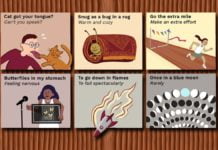Homonymy refers to a linguistic phenomenon where two or more words have the same spelling or pronunciation but different meanings. There are two main types of homonyms: homophones and homographs. Homophones are words that sound the same but have different meanings, such as “write” and “right.” Homographs, on the other hand, are words that are spelt the same but have different meanings, like “lead” (to guide) and “lead” (a heavy metal).
The word homonym comes from the conjunction of the Greek prefix homo (meaning same) and the suffix onym (meaning name). Thus, it refers to two or more distinct words sharing the same name.
Understanding homonymy is essential for effective communication and comprehension of language. When encountering homonyms, it can be easy to misinterpret the intended meaning of a word, leading to confusion or misunderstandings. By recognizing and understanding homonyms, individuals are better equipped to accurately interpret the intended meaning of words and avoid potential communication breakdowns. It also aids in developing vocabulary and language skills, as it requires a deeper understanding of word meanings and contexts.
Homophones
Homophones are words that have the same pronunciation but different meanings and often different spellings. They often need clarification on writing and speaking, as choosing the correct homophone is essential for conveying the intended message accurately. A thorough understanding of homophones allows individuals to communicate effectively and avoid misunderstandings.
Here are some examples:
To, Too, Two:
“To” refers to a direction or destination (“I’m going to the store.”).
“Too” means also or excessively (“I want some cake too.”).
“Two” is the number 2 (“I have two cats.”).
Their, There, They’re:
“Their” indicates possession (“That’s their car.”).
“There” refers to a location (“I will meet you there.”).
“They’re” is a contraction of “they are” (“They’re going to the party.”).
Flour, Flower:
“Flour” is a powdery substance used in baking (“Add two cups of flour.”).
“Flower” is a bloom from a plant (“She received a bouquet of flowers.”).
Homographs
Homographs are words with the same spelling but different meanings and may or may not have the same pronunciation. Understanding and correctly using homographs are essential for effective communication, as they can lead to clarity and clarity in written or spoken language. Therefore, individuals should be familiar with the various meanings of homographs to ensure clarity and accuracy in their communication.
Here are some examples:
Bow (noun) / Bow (verb):
As a noun, “bow” refers to a curved weapon or a tied ribbon.
As a verb, “bow” means to bend forward at the waist, as in greeting.
Tire (noun) / Tire (verb):
As a noun, “tire” refers to a rubber covering around a wheel.
As a verb, “tire” means to exhaust or make weary.
Lead (noun) / Lead (verb):
As a noun, “lead” refers to a heavy metal.
As a verb, “lead” means to guide or direct.
Related Terms
Several similar linguistic concepts are related to homonymy. The term homonym is ambiguous because there are several ways that two meanings can share the ‘same name’ and because educated speakers use the term differently, and dictionaries record these variant meanings. The terms homograph and homophone are usually defined in the same way, meaning the same spelling and the same sound, respectively, and a heteronomy and a homonym can be seen as respective subclasses of these.
Homophones
Homophones are words that share the same pronunciation regardless of how they are spelt. Homophones may be spelled the same (in which case they are also homographs) or spelled differently (in which case they are heterographs). Homographic examples include tire (to become weary) and tire (on the wheel of a car). Heterographic examples include to, too, two and there, their, they’re.
Homonyms
Homonyms can be seen as the subclass of homophones spelt the same, which is logically the same as the subclass of homographs pronounced the same. This means words are spelt and pronounced the same (but with different meanings).
Homographs
Homographs are words that share the same spelling regardless of their pronunciation. Homographs may be pronounced the same, in which case they are also homophones -for example, bark (the sound of a dog) and bark(the skin of a tree). Alternatively, they may be pronounced differently and are also heteronyms – for example, row (argument) and row (propel with oars).
Heteronyms
Heteronyms can be seen as the subclass of homographs (words with the same spelling) with different pronunciations. That is, they are homographs that are not homophones. This means words spelt the same but with different pronunciations (and meanings). Such words include desert (to abandon) and desert (arid region), row (to argue or an argument), and row (as in to row a boat or a row of seats). Note that the latter meaning also constitutes a homophone. Heteronyms are also sometimes called heterophones.
Polysemes
Polysemes are words with the same spelling and distinct but related meanings. The distinction between polysemy and homonymy is often subtle and subjective; not all sources consider polysemous words homonyms. Words such as “mouth”, meaning either the orifice on one’s face or the opening of a cave or river, are polysemous and may or may not be considered homonyms.
Capitonyms
Capitonyms are words that share the same spelling but have different meanings when capitalized (and may or may not have different pronunciations). Such words include polish (to make shiny) and Polish (from Poland).
Homonymic Conflict
Homonymy can lead to communicative conflicts and thus trigger lexical change. This is known as homonymic conflict.
Here are some common homonym examples:
Atmosphere -the gases surrounding the earth / the mood of a situation
Bail -to clear out water / to release a prisoner
Band -a ring, sometimes symbolizing eternity / a musical group
Beat -to overcome something / to feel exhausted
Capital -the chief city of a state / a crime punishable by death
Cleave -to split or sever / to adhere to
Dive -to go down quickly / an unpleasant place
Employ -to put into use / to hire someone for a job
File -to store computer data / to make a formal request
Fine -being of high quality / sum of money used as a penalty
Grave -something very serious / a place to bury the dead
Hide -to keep something secret / the skin of an animal
Iron -to press or smooth / silvery-grey metal
Jade -a hard, greenstone / a hardened or bad-tempered woman
Lark -a small bird / something done for fun
Objective -not being influenced by prejudice / the lens of a microscope or camera
Plaque -an ornamental plate or slab that commemorates a person or event / a deposit on teeth prone to bacteria
Refrain -to stop oneself from doing something / a repeated line in music or poetry
Reticule -at a distance or disconnected / an unlikely possibility
Tender -sensitive or painful to the touch / soft food, i.e. a chicken tender
Understanding the context in which these words are used is crucial for correctly interpreting their meanings. The presence of homonyms can sometimes lead to confusion, so context becomes a critical factor in determining the intended meaning of a given sentence.






























